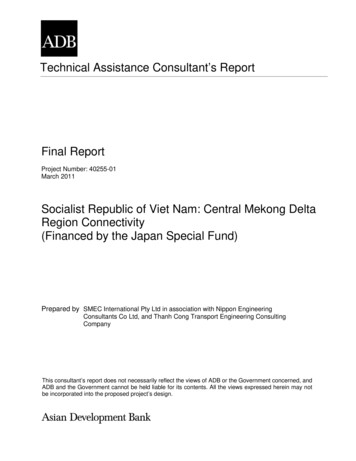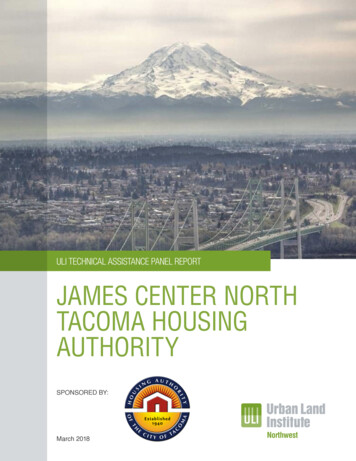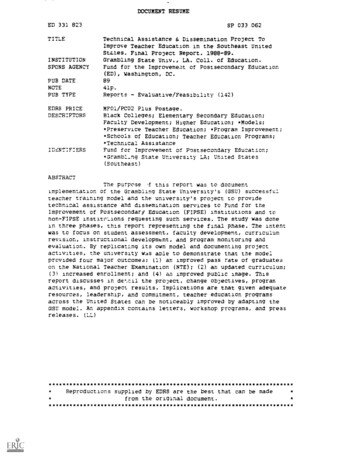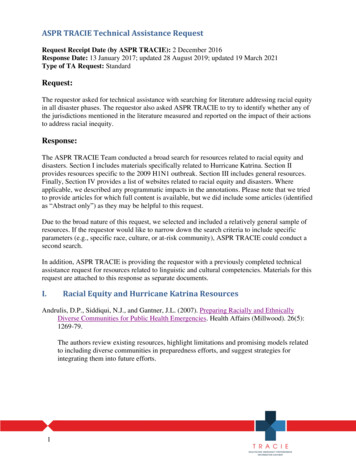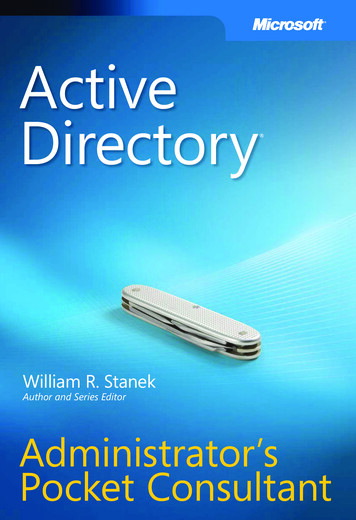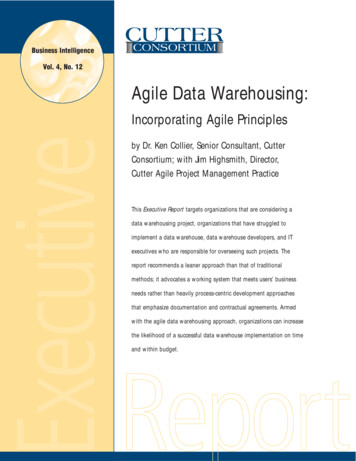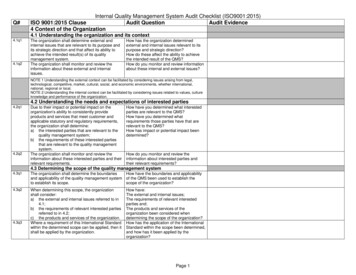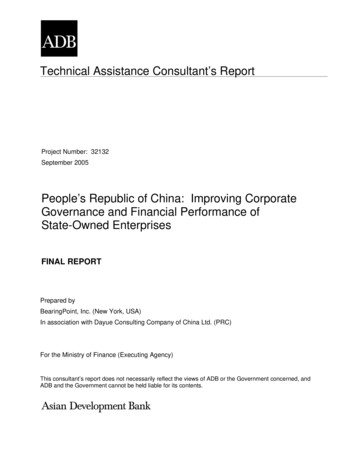
Transcription
Technical Assistance Consultant’s ReportProject Number: 32132September 2005People’s Republic of China: Improving CorporateGovernance and Financial Performance ofState-Owned EnterprisesFINAL REPORTPrepared byBearingPoint, Inc. (New York, USA)In association with Dayue Consulting Company of China Ltd. (PRC)For the Ministry of Finance (Executing Agency)This consultant’s report does not necessarily reflect the views of ADB or the Government concerned, andADB and the Government cannot be held liable for its contents.
INTERNATIONAL PUBLIC SERVICES – EMERGING MARKETS DIVISIONFinal ReportSeptember 23, 2005ADB TA No. 3933 - PRCTABLE OF CONTENTSEXECUTIVE SUMMARY . 71. THE ENHANCED EPES. 91.1 ENHANCED EPES STRUCTURE & SCORING .131.1.1 Enhanced EPES Structure .131.1.2 Enhanced EPES Scoring.161.2 COMPARISON OF CURRENT EPES SCORES WITH ENHANCED EPES SCORES .201.3 RESULTS OF BETA-TESTING OF ENHANCED EPES.231.3.1 Measuring Performance of SASAC’s 189 SOEs .241.3.2 Measuring Performance of Publicly-Listed SOEs.301.3.3 Measuring Performance of SOE Executives & Directors .341.4 RECOMMENDATIONS FOR FUTURE DEVELOPMENT AND TESTING OF ENHANCED EPES .371.4.1 Internet Deployment of the Enhanced EPES .371.4.2 Expanded use of Percentile Ranking & Quantitative Measurements .371.4.3 Weighting of Non-Financial Measurements should be carefully considered .371.4.4 Additional or Replacement Measures for the Enhanced EPES.401.4.5 Implementation Challenge: Reference Groups .411.4.6 Implementation Challenge: SASAC Executive Understanding & Support.421.4.7 Auditing & Verification of Enterprise Information .431.4.8 Additional Testing Prior to Deployment .432. INTERNATIONAL BENCHMARKING. 452.1 INDUSTRIAL CLASSIFICATION CODES .462.2 SOURCES OF BENCHMARK & FINANCIAL INFORMATION .463. SOFTWARE DEVELOPMENT . 483.1 STEP 1 SOFTWARE DEVELOPMENT: LAPTOP-BASED ENHANCED EPES.493.1.1 Data interface module .493.1.2 Data management module .493.1.3 Evaluation scoring module .503.1.4 Result analysis and management module.513.1.5 Database Description .513.1.6 Step 1 Software Development Plan & Budget.513.2 STEP 2 SOFTWARE DEVELOPMENT – INTERNET-BASED ENHANCED EPES .523.2.1 System management module.533.2.2 Evaluation system definition module .533.2.3 Step 2 Software Development Plan & Budget.543.3 DESCRIPTION OF SOFTWARE PROTOTYPE (LAPTOP VERSION) OF ENHANCED EPES .56Improving Corporate Governance & FinancialPerformance of SOEs2 2005 BearingPoint, Inc.
INTERNATIONAL PUBLIC SERVICES – EMERGING MARKETS DIVISIONFinal ReportSeptember 23, 2005ADB TA No. 3933 - PRC4. CORPORATE GOVERNANCE - INTRODUCTION AND OVERVIEW . 574.1 MAIN INSTRUMENTS RELATED TO CORPORATE GOVERNANCE AND THEIR SCOPE .584.2 PROGRESS IN REFORMING THE FRAMEWORK FOR GOVERNANCE .584.2.1 Assess Corporate Governance structures.584.2.2 Examine Board Structures.594.2.3 Examine Various Systems, Controls, Functions, and Practices .594.2.4 Examine Oversight Structures.604.3 COMPARISON OF CHINESE LEGAL FRAMEWORK WITH OECD CODE OF CORPORATEGOVERNANCE .624.4 SOE COMPLIANCE WITH THE CODE OF CORPORATE GOVERNANCE FOR SOES .664.5 CORPORATE GOVERNANCE – SUGGESTED RECOMMENDATIONS .675. OVERVIEW OF AREAS FOR FURTHER ADB COOPERATION. 686. IN DEPTH DESCRIPTION OF SASAC’S ORGANIZATIONAL RESPONSIBILITIES. 707. SUMMARY OF TRAINING CONDUCTED DURING PROJECT. 738. ACTIVITIES AFTER SUBMISSION OF THE DRAFT FINAL REPORT ACTIVITIES. 738.1EPM & CORPORATE GOVERNANCE TRAINING PROGRAM IN GERMANY .738.2TA FINAL CONFERENCE IN BEIJING, APRIL 2005 .77APPENDICESAPPENDIX 1: ENHANCED EPES SCORING – “STEP 1” SCORING VS. “STEP 2” SCORING. . . . . . . . . . 81APPENDIX 2: COMPARISON OF CURRENT EPES WITH ENHANCED EPES. . . . . . . . . . . . . . . . . . . . .85APPENDIX 3: ENHANCED EPES RESULTS FOR 6 SASAC-SUPERVISED SOES. . . . . . . . . . . . . . . . . .87APPENDIX 4: INTERNATIONAL BENCHMARK EXAMPLE: STEEL INDUSTRY. . . . . . . . . . . . . . . . . . . . . .99APPENDIX 5: EXAMPLE OF WEB PAGES FOR SOFTWARE PROTOTYPE . . . . . . . . . . . . . . . . . . . . . .107APPENDIX 6: CHINESE LEGAL FRAMEWORK & OECD CORPORATE GOVERNANCE PRINCIPLESCOMPARISON . . 146APPENDIX 7:AGENDA FOR TA-3933 FINAL CONFERENCE, APRIL200 .160Improving Corporate Governance & FinancialPerformance of SOEs3 2005 BearingPoint, Inc.
INTERNATIONAL PUBLIC SERVICES – EMERGING MARKETS DIVISIONFinal ReportSeptember 23, 2005ADB TA No. 3933 - PRCABBREVIATIONSABC- Activity Based Costing, an advanced accounting methodology that allocatescosts to specific business activitiesADB- Asian Development BankBPM- Business Performance MeasurementBSC- Balanced Scorecard, a performance measurement frameworkCGRI- Corporate Governance Rating Index, a discrete deliverable of this TACRM- Customer Relationship Management, a field of business strategy that focuseson increasing knowledge about a businesses customersCurrent EPES- The performance measurement system used by the Chinese Governmentsince 1998EA- Executing Agency (the SASAC)Enhanced EPES- The upgraded performance measurement system being delivered by this TAProject.EPES- Enterprise Performance Evaluation System, a performance measurementmethodology that is being upgraded by this TA Project.EVAEconomic Value Added, a method of measuring business performanceSASAC- State-owned Assets Supervision & Administration Commission, the EA forthis TASOEs- State-owned EnterprisesTA- Technical AssistanceTA 3933-PRCTORThe TA document released by the ADB that contains the TOR for this Project- Terms of Reference that contains the specific deliverables for the ProjectImproving Corporate Governance & FinancialPerformance of SOEs4 2005 BearingPoint, Inc.
INTERNATIONAL PUBLIC SERVICES – EMERGING MARKETS DIVISIONFinal ReportSeptember 23, 2005ADB TA No. 3933 - PRCTRANSLATION TERMINOLOGYEnglish TerminologyChinese TranslationBenchmarks— 标准Breakpoint— 临界值Business Strategy— 商业战略,经营战略Corporate Governance— 公司治理Customer perspective— 客户角度Equity— 净资产,所有者权益Financial perspective— 财务角度Internal process perspective— 内部流程角度Learning and growth perspective— 学习与成长角度Measures— 指标,衡量指标,考核指标Percentile rank— 百分比等级Reference group— 参照组Revenue— 收入,销售收入Scoring methodology— 评分办法Strategy-focused organization— 战略中心型组织Strategy map— 战略图Supplementary financial factor— 补充财务指标,修正财务指标Targets— 目标值,目标Weighted average— 加权平均Weights— 权重THIS DOCUMENT IS PROTECTED UNDER THE COPYRIGHT LAWS OF THE UNITED STATES AND OTHER COUNTRIES AS ANUNPUBLISHED WORK. THIS DOCUMENT SHALL NOT BE DISCLOSED, DUPLICATED, USED, OR DISCLOSED, IN WHOLE OR INPART, FOR ANY PURPOSE, OUTSIDE THE ASIAN DEVELOPMENT BANK OR ANY OF THE EXECUTING OR IMPLEMENTINGAGENCIES IDENTIFIED UNDER THIS TA-3933-PRC. ANY OTHER USE OR DISCLOSURE IN WHOLE OR IN PART OF THISINFORMATION WITHOUT THE EXPRESS WRITTEN PERMISSION OF BEARINGPOINT, INC. IS PROHIBITED. 2005 BearingPoint, Inc. (Unpublished) All rights reservedImproving Corporate Governance & FinancialPerformance of SOEs5 2005 BearingPoint, Inc.
INTERNATIONAL PUBLIC SERVICES – EMERGING MARKETS DIVISIONFinal ReportSeptember 23, 2005ADB TA No. 3933 - PRCEXECUTIVE SUMMARYImproving Corporate Governance & FinancialPerformance of SOEs6 2005 BearingPoint, Inc.
INTERNATIONAL PUBLIC SERVICES – EMERGING MARKETS DIVISIONFinal ReportSeptember 23, 2005ADB TA No. 3933 - PRCEXECUTIVE SUMMARYBearingPoint designed a three-phase approach for executing and delivering the technicalassistance under TA 3933-PRC “Improving Corporate Governance & Financial Performance ofSOEs.” Working in close coordination with SASAC, this approach contains the delivery of specifictechnical assistance and work products during each Phase.1Phase One, the corporate governance phase, includes providing both corporate governance adviceand delivering a Corporate Governance Rating Index (CGRI). Phase Two includes designing anddelivering an enhanced enterprise evaluation methodology (enhanced EPES). Phase Threeincludes software design, international benchmarking assistance and advice, site testing of theenhanced EPES, and other discrete activities as outlined in the TA.During Phase One, the Project designed a CGRI to measure the degree to which SOEs complywith international standards of corporate governance, established Chinese corporate governancelaws and regulations, and the OECD Principles of Corporate Governance2. The CGRI wasdelivered on May 31, 2004 in the Project’s 1st Interim Report and contained a scoring system thatmeasures corporate governance compliance and practices in 5 areas: The Role of the Board ofDirectors, Transparency & Disclosure, Audit, Stakeholders & Corporate Citizenship, and EquitableTreatment of Shareholders. The CGRI was designed so that it could be incorporated into theenhanced EPES.During Phase Two, the Project designed and delivered an enhanced enterprise evaluationmethodology in close coordination and partnership with SASAC. The Government of the PRC hadalready developed an enterprise evaluation methodology (the current Enterprise PerformanceEvaluation System, or “current EPES”3) that is derived from the Balanced Scorecard (BSC)performance measurement system4. However, the Chinese government had been unable to widelydeploy this system due to a variety of factors. These factors include reliance on subjective scoringby teams of evaluation experts, a complex scoring methodology, and an inability to use the entirescoring system on more than a couple dozen enterprises.The enhanced EPES includes 5 categories of objectives and measures, called Perspectives:Financial, Customer, Internal Processes, Learning & Growth, and Corporate Governance. These 5Perspectives include 19 objectives and 33 separate measures. The 33 measures were selectedbased in part on more than 10 years experience, scientific research, and international best practice1234The BearingPoint Team Leader for the Project is Christian C. Johnson, Christian.Johnson@bearingpoint.com,Phone: (212) 426-1449, Fax: (212) 208-4672, or cjohnson@mba1993.hbs.edu.The Organization for Economic Cooperation & Developed (OECD) Principles of Corporate Governance is viewedglobally as the “international benchmark” for corporate governance. In May 1999 ministers representing the 29governments that comprise the OECD voted unanimously to endorse these Principles. The Principles werenegotiated after extensive consultations with international investors, governments, and regulators around the world.The World Bank, the International Monetary Fund, the United Nations, and international investors use these Principlesto define acceptable standards of corporate governance.The terms “current EPES” or “EPES” will be used to describe the system in place prior to the commencement of thisTA Project. The term “Enhanced EPES” is used when referring to the updated and enhanced system designed anddelivered by this project.Drs. Kaplan and Norton first introduced the BSC performance measurement system in the Harvard Business Reviewin 1992. In 2004, more than 60% of the largest 1000 global organizations use the BSC. Moreover, a 2001 survey byBusiness Intelligence of 200 large companies in 20 countries reported that 57% had adopted a BSC performancemeasurement methodology. The BSC framework has evolved from performance measurement to performancemanagement to strategic management over a period of more than 10 years. Performance measurement enablesperformance managementImproving Corporate Governance & FinancialPerformance of SOEs7 2005 BearingPoint, Inc.
INTERNATIONAL PUBLIC SERVICES – EMERGING MARKETS DIVISIONFinal ReportSeptember 23, 2005ADB TA No. 3933 - PRCin the area of performance measurement systems and the Balanced Scorecard. Finally, theenhanced EPES includes both “percentile ranking” (variable) scoring as well as “yes/no” scoring (inwhich a company either receives full credit or no credit).During Phase Three, more fully described in this report, the project beta-tested the enhanced EPESat various SOEs, both those under the direct supervision of SASAC as well as an SOE listed on aChinese stock exchange. In addition, the project delivered international benchmarking assistanceand corporate governance advice to SASAC. The project also researched the necessary softwareand hardware needed for full-scale implementation of the Enhanced EPES. Based on this researcha two-step approach is outlined that will enable SASAC to test, to program, and to deploy theenhanced EPES to the 189 large SOE conglomerates under direct SASAC supervision as well asthe more than 10,000 SOE subsidiaries of those 189 SOE conglomerates. This report provides anin-depth update of the work performed during Phase Three and summarizes the Project’smilestones and assistance to the PRC.Improving Corporate Governance & FinancialPerformance of SOEs8 2005 BearingPoint, Inc.
INTERNATIONAL PUBLIC SERVICES – EMERGING MARKETS DIVISIONFinal ReportSeptember 23, 2005ADB TA No. 3933 - PRC1. THE ENHANCED EPES5A major focus of this TA Project is the delivery of a business performance measurement and controlsystem that will enable the Chinese Government (more specifically, SASAC) to create anoverarching strategy for its SOEs and to communicate that strategy to SOE enterprise managers inthe form of specific business goals. This business performance measurement system also needsto measure progress toward those goals and to provide meaningful feedback to enterprisemanagers about areas of strength or weakness.Throughout the TA Project, the Project Team interviewed and met with Senior SASACrepresentatives to determine the long-term strategy for China’s SOEs. Based on this strategy, theProject Team developed a performance measurement system designed to communicate thatstrategy to SOE enterprise managers in the form of specific business objectives and specificmeasures. A blueprint of the strategy and performance measurement system developed by theProject is contained below. The figure contains a Strategy Map6 for China’s SOEs that outlinesspecific business goals that will enable SOEs to achieve SASAC’s long-term objectives.A strategy map is excellent management tool for communicating strategy and high-level strategicgoals. A strategy map is a single diagram that graphically illustrates the key strategic objectives ofa single organization or group of organizations. These objectives are defined in multiple categories,called Perspectives. The Project Team recommends that five Perspectives be included in theStrategy Map for the Enhanced EPES: Financial; Customer; Process; Learning and Growth; andCorporate Governance.[This space intentionally blank]56ndThe Enhanced EPES and its design are more fully documented and explained in the Project’s 2 Interim Report.ndStrategy Maps are more fully described in the Project’s 2 Interim Report and in the book Strategy Maps by Robert S.Kaplan and David P. Norton, (Boston: Harvard Business School Press, 2004).Improving Corporate Governance & FinancialPerformance of SOEs9 2005 BearingPoint, Inc.
INTERNATIONAL PUBLIC SERVICES – EMERGING MARKETS DIVISIONFinal ReportSeptember 23, 2005ADB TA No. 3933 - PRCSASAC 2004 EPES Strategy MapLong Term Vision:Globally Competitive EnterprisesMaintain & IncreaseState EquityGuide SOEsTo Serve as Policy Instrumentfor Social/Market Stability &National DevelopmentIncrease SOE GlobalCompetitivenessFinancialIncrease Profitability& Cash FlowImprove Solvency & FinancialRisk ManagementGrow Enterprise RevenuesIncrease FinancialContribution to SocietyCustomerImprove Market PerformanceImprove Customer Loyalty[Retention Satisfaction]Acquire New CustomersProcessEstablish & improveStrategic ManagementProcessOptimize CapitalStructure/FinancialPerformanceImprove Innovation inProducts/servicesImprove Alignment withGovernment’s Social,Environmental & RegulatoryObjectivesLearning & GrowthImprove Management &Employee MotivationImprove Training InvestmentImprove Employee ProductivityCorporate GovernanceTransparency &Disclosure*Equitable Treatmentof ShareholdersAuditStakeholders &Corp. CitizenshipRole of the Board ofDirectors*For non-100% Government owned SOEsSource: BearingPoint TA 3933 Project Team & SASAC ManagementThe SASAC Strategy Map above provides a high level view of the goals and strategic drivers ofSASAC’s general strategy for the SOEs under its influence or control. This generic Strategy Map,while useful in communicating and updating SASAC’s general strategy, was also used as the basisfor designing the Enhanced EPES. The major difference between the SASAC Strategy Map andthe Enhanced EPES is that the Enhanced EPES provides specific weights for each objective in theSASAC Strategy Map.A graphical overview of the Enhanced EPES, with component weightings, is provided below.[This space intentionally blank]Improving Corporate Governance & FinancialPerformance of SOEs10 2005 BearingPoint, Inc.
INTERNATIONAL PUBLIC SERVICES – EMERGING MARKETS DIVISIONFinal ReportSeptember 23, 2005ADB TA No. 3933
3 The terms “current EPES” or “EPES” will be used to describe the system in place prior to the commencement of this TA Project. The term “Enhanced EPES” is used when
